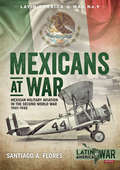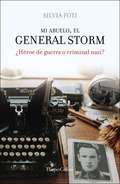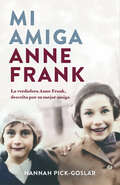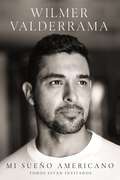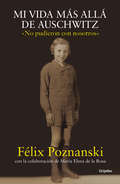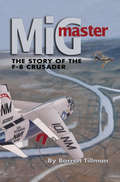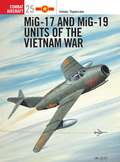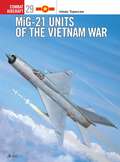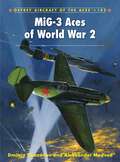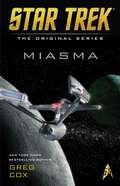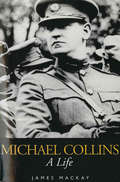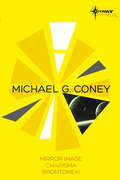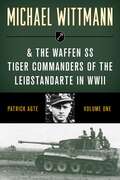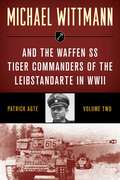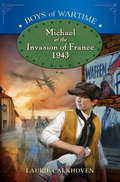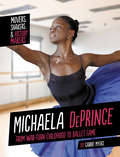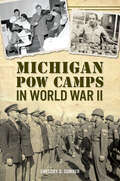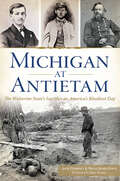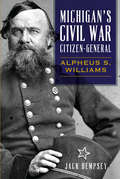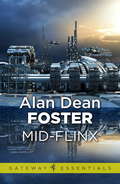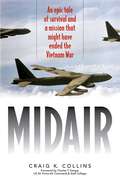- Table View
- List View
Mexicans at War: Mexican Military Aviation in the Second World War, 1941–1945 (Latin America at War #9)
by Santiago A. FloresThis book introduces the reader to an unknown Ally of the Second World War. Few people remember that Mexico, like Brazil, took an active part in that conflict. This volume covers Mexican participation in the Second World War for the first time using photos, documents and testimony from official and personal archives. Mexican nationals or those of Mexican descent were already volunteering for the Allied air forces of the British Commonwealth and the Free French naval and air forces While the Mexican Republic first had to defend both its coasts and its shipping from enemy submarines, using its obsolete general purpose biplanes, following the sinking of Mexican ships by German u-boats the first North American Texan armed trainers entered service in the Gulf of Mexico, earning the title of the ‘Mexican Dive Bomber’. Due to the necessities of the war, the service had to reorganize its aviation assets to be able to receive a larger number of American-built lease aircraft, which started the modernization and reorganization process that is felt even today. The war affected all aspect of Mexican military aviation from tactical units, to training, to logistics and military doctrine. This also led to the establishment of Mexican Naval Aviation which led, in turn, to the creation of its first naval squadron to patrol the Gulf of Mexico. One aspect that the war affected was the training of the new generation of military personnel, some of whom would later see action before the end of the war. As Mexico was securing its coasts and sending aviation personnel to train in the USA, it would later field its fighter squadron to participate in the liberation of the Philippine islands. By the end of the war the Mexican Air Force had experienced its most rapid growth since it was officially established back in February 1915. The text is fully supported by numerous previously unpublished photographs and color profiles showing camouflage and markings.
Mi abuelo, el general Storm: ¿Héroe o criminal nazi?
by Silvia FotiTras crecer bajo la sombra de un abuelo heroico y reconocido por sus acciones en la rebelión lituana contra el comunismo, la autora se da a la tarea de escribir un libro biográfico, con la idea de que esté engrandecerá el recuerdo de su familia y el rol que el General Noreika jugó en su país natal.Después de una primera visita a Europa, la autora descubre un rumor perturbador: su abuelo participó en la matanza de judíos en su país natal. En este momento la biografía toma un giro: no sólo debe engrandecer el legado de su abuelo, sino además exonerarlo de estas terroríficas acusaciones. Le tomó 13 años, dos maestrías y largas temporadas en Europa llegar a la verdad. Sus investigaciones no sólo demuestran que Noreika participó conscientemente en la matanza de miles de judíos, sino que estaba de acuerdo con que esta etnia representaba un grave peligro para su país en ese momento.
Mi amiga Anne Frank: La verdadera Anne Frank, descrita por su mejor amiga
by Hannah Pick-GoslarLas conmovedoras memorias de Hannah Pick-Goslar, superviviente del holocausto, la mejor amiga de Anne Frank. Una mirada íntima a sus vidas y a su amistad. Con cinco años, Hannah Pick-Goslar huyó con su familia a Ámsterdam para escapar de la Alemania nazi. El primer día de cole allí, entabló amistad con una niña extrovertida y avispada llamada Anne Frank. Durante unos años maravillosos las dos fueron inseparables y disfrutaron de tranquilas fiestas de pijamas y juegos infantiles en el barrio de Rivierenbuurt.Sin embargo, un día de 1942 las vidas de ambas cambiaron para siempre. La ocupación nazi se intensificó y de pronto Anne y su familia desaparecieron. Mientras Hannah se preguntaba por el paradero de su amiga, el destino de su propia familia tomó un nuevo rumbo: los arrestaron y enviaron a Westerbork, un campo de tránsito, antes de transportarlos a Bergen-Belsen. En este campo de concentración, rodeada de muerte y de miseria, Hannah recibió noticias asombrosas de su amiga y no dudó en poner su vida en peligro para ayudarla.«De niña vi al mundo que amaba desmoronarse y desaparecer, vi cómo un odio sin sentido lo destruía y, junto a él, a mi mejor amiga Anne». En este relato lleno de esperanza, fuerza y resistencia, Hannah Pick-Goslar narra una historia de supervivencia y un testimonio inolvidable sobre el poder eterno de la amistad, el amor y la memoria. Reseñas:«La historia de Hannah concluye la que Anne no pudo terminar. Te parte el corazón, pero a la vez es un canto a la vida y cuenta una verdad que ahora mismo necesitamos más que nunca».Dra. Edith Eva Eger, autora de La bailarina de Auschwitz «Un relato insólito sobre el amor, la pérdida y el poder de la amistad en los momentos más aciagos.Este libro, al igual que su autora, es un complemento imprescindible de la vida de Anne Frank».Jack Fairweather, autor de El voluntario, galardonado con el Premio Costa «Hannah Pick-Goslar describe los momentos alegres de su amistad con Anne Frank y las terribles circunstancias que vivieron bajo el régimen nazi… Un relato devastador sobre el Holocausto».Time Magazine «Una amistad hermosa y compleja».New York Post «Sin duda, Hannah Pick-Goslar tiene una historia que contar, y lo hace con gran claridad y convicción. Su experiencia se parece a la de Anne Frank en muchos aspectos».Washington Post
Mi corazón irlandés
by Francine J.C.Una novela romántica ambientada en la idílica y verde Irlanda. Una historia de segundas oportunidades y amores prohibidos. No importa que creas o no en el destino, ya está escrito y acabarás por encontrarte con él. Elena Urzaiz, una joven enfermera a quien la vida parecía haber obsequiado con todo lo necesario para ser feliz, ve cómo esta se trunca por una funesta relación que la marca para siempre y le obliga a tener que huir de España para deshacerse de su acosador, un acaudalado médico sin escrúpulos. Gracias a su tío paterno, Tomás, capitán del ejército de tierra, y con la colaboración indispensable de los amigos de este, llegará a Irlanda. Allí ejercerá su profesión dentro del cuartel militar de la ciudad de Cork, en Collins Barracks. Ningún comienzo es fácil, y menos aún el de Elena, hasta que conoce al apuesto teniente Joe McCarthy. Aunque en un primer encuentro no empiezan con buen pie, poco a poco la atracción que sienten el uno por el otro los llevará a entablar una amistad que desembocará en un apasionado y prohibido romance. Intentará, día tras día, rehacer su vida lo mejor que puede, pero su pasado no dejará de atormentarla...
Mi sueño americano: Todos están invitados
by Wilmer ValderramaMi sueño americano es el conmovedor libro de memorias del actor, productor y activista Wilmer Valderrama, que ahonda en su educación en Venezuela, donde fue criado por dos padres muy trabajadores, mientras su familia atravesaba un país en rápida transformación y el ascenso de Hugo Chávez.Con la economía derrumbándose a su alrededor y su medio de vida desapareciendo, la familia decide huir del país. De repente, el niño al que le encantaba montar a caballo y soñar con ser el Zorro de su serie favorita de televisión en blanco y negro, tuvo que crecer rápidamente y viajó, siendo un adolescente, desde un pequeño pueblo de Venezuela a la gran ciudad de Los Ángeles.En los años siguientes, Valderrama crearía el exitoso programa Yo Mamma, deleitaría a los niños con Handy Manny, pondría voz al personaje principal de Encanto de Disney y mucho más, hasta unirse al reparto del exitoso programa NCIS en 2016.Sin embargo, fue a través del servicio a los demás y de su primer viaje con United Service Organization (USO por sus siglas en inglés) donde Valderrama encontró su vocación ampliada, entreteniendo y animando a las tropas estadounidenses en todo el mundo. De repente, quiso hacer todo lo que pudiera, dedicando su tiempo y sus esfuerzos a retribuir al país que considera su hogar.A través de su trabajo, Valderrama espera demostrar su amor y su gratitud por el país que cambió su vida. Mi sueño americano entrelaza las historias personales de Valderrama con las de personas notables que ha conocido a lo largo de su viaje filantrópico. Sin embargo, esta no es solo la historia de Valderrama, sino también una visión de Estados Unidos de América a través de los ojos de un inmigrante, tanto en sus asombrosas maravillas inigualables como en todos sus retos. Es la historia profunda y apasionante de alguien que encontró el camino y ahora invita a cuantos sea posible a acompañarle en la aventura.An American StoryAn American Story is the stirring memoir by actor, producer, and activist Wilmer Valderrama, delving into his upbringing in Venezuela where he was raised by two hard working parents as they navigated their family through a rapidly changing country and the rise of Hugo Chavez. With the economy crashing around them and their livelihood disappearing, the family decides to flee the country. Suddenly, the young boy who had loved riding his horse and dreaming of being Zorro from his favorite black and white tv show had to grow up quickly, journeying as a teenager from a tiny little pueblo in Venezuela to the big city of Los Angeles.It was through service to others and his first USO trip, however, where Valderrama found his expanded calling, entertaining and encouraging U.S. troops around the world. Suddenly, he wanted to do as much of this as he could, dedicating his time and efforts to giving back to the country he calls home.Through his work, Valderrama hopes to demonstrate his love and gratitude for the country that changed his life. An American Story weaves Valderrama&’s personal stories with those of the remarkable people he&’s met along his philanthropic journey. This isn&’t just Valderrama&’s story, though. It&’s a view of America through an immigrant&’s eyes, in both its stunning unmatched wonders and all of its native challenges. It is the profound and gripping story of someone who found the way and is now inviting as many as possible to join him on the adventure.
Mi vida más allá de Auschwitz: No pudieron con nosotros
by Félix Poznanski María Elena de la RosaMi abuelo siempre decía que el ser humano tiene la capacidad de olvidar, pero yo tenía la necesidad de saber qué era aquello que él no quería recordar. «Me paré sobre los lugares donde millones de personas vivieron la tragedia. Intenté imaginarme todo el espanto, la masacre... Y pensé en mi abuelo, un niño de tan sólo 8 años, separado de su familia, siendo completamente torturado. A diferencia de mí, que entré sin que nadie me obligara y con la libertad de salir cuando quisiera. Me sentí orgullosa de mi abuelo pero al mismo tiempo imponente, triste y con mucho enojo. Vine para tratar de entender cómo pudo ser posible, y me quedo con más dudas todavía. Vine en honor a mi abuelo que logró sobrevivir y, sobre todo, para demostrar que realmente no pudieron con nosotros». Tatiana Poznanski, Auschwitz 2019
MiG Master
by Barrett TillmanTo be equally enjoyed by professional aviators and aviation buffs with limited technical knowledge, this biography brings to life the legendary aircraft that scored the highest kill ratio of any U.S. fighter aircraft in the Vietnam War. The book is filled with authentic re-creations of Crusader-MiG fights and vivid descriptions of the people and events that are part of the F-8 story, including John Glenn's 1957 record-breaking flight across the United States in three hours and twenty-three minutes. As the Navy's first supersonic aircraft, the Crusader holds an honored spot in carrier flying, and the author shows why it is called one of the most capable, versatile, and long-lived aircraft in naval aviation history. Barrett Tillman effectively combines an exciting account of the F-8's operational history with a detailed and authoritative explanation of its design, construction, and modifications. Tillman recalls the years of frustration and experimentation spent in refining the aircraft and its gunnery system, and then takes the reader through key actions in Vietnam where seasoned pilots handled their "rambunctious steeds" with scarcely a glance in the cockpit. Extensive appendixes provide further details.
MiG Pilot: The Final Escape of Lieutenant Belenko
by John BarronTells of the life of Lieutenant Viktor Ivanovich Belenko in Tokyo, Moscow and Tokyo and his secrets in regards to the Soviet Union.
MiG-17 and MiG-19 Units of the Vietnam War
by Iain Wyllie Istvan ToperczerThe erstwhile enemy of the USAF and US Navy during the nine years of American involvement in the Vietnam War (1955-1975), the Vietnamese Peoples' Air Force (VPAF) quickly grew from an ill-organised rabble of poorly trained pilots flying antiquated communist aircraft into a highly effective fighting force that more than held its own over the skies of North Vietnam. Flying Soviet fighters like the MiG-17, and -19, the VPAF produced over a dozen aces, whilst the Americans managed just two pilots and three navigators in the same period.
MiG-21 Units of the Vietnam War
by Mark Styling Istvan ToperczerOsprey's study of the use of MiG-21 Units in the Vietnam War (1955-1975). Having honed their piloting skills on the subsonic MiG-17 and transonic MiG-19, the Vietnamese Peoples' Air Force (VPAF) received their first examples of the legendary MiG-21 supersonic fighter in 1966. Soon thrown into combat over North Vietnam, the guided-missile equipped MiG-21 proved a deadly opponent for the USAF, Navy and Marine Corps crews striking at targets deep into communist territory. Most of the VPAF's 12+ aces scored their bulk of their kills in the MiG-21, which was then the best fighter produced by Russia's premier fast jet manufacturer, Mikoyan Gurevich. Well over 200 MiG-21s were supplied to the VPAF, and the numerous models and the schemes they wore are chronicled in great detail in this unique volume.
MiG-3 Aces of World War 2
by Dmitriy Khazanov Andrey YurgensonCreated by ex-Polikarpov designers Ivanovic Mikoyan and Mikhail Gurevich, the MiG-1/3 family of fighters was built to satisfy a Soviet Air Force requirement for an advanced, fast, high altitude fighter. Entering service in the spring of 1941, the problematic MiG-1 had its handling problems rectified with the hasty production of the MiG-3 - the latter had its Mikulin engine moved further forward, increased outer wing dihedral and a strengthened fuselage. As of 22 June 1941, Air Force manoeuvre units in the five borderline military districts could field 917 MiG-3s. Many of these were destroyed on the ground when the Germans launched Operation Barbarossa. Nevertheless, enough examples survived to allow pilots such as Stepan Suprun (Twice Hero of the Soviet Union), Aleksandr Pokryshkin (Thrice Hero of the Soviet Union) and Lev Shestakov (Hero of the Soviet Union) to claim a number of victories on the type. Early successes by units such as 23rd and 28th IAPs resulted in 35 aerial victories being claimed by MiG-3 pilots in the first eight days of the Great Patriotic War. Other units enjoyed similar levels of success, with MiG-3-equipped 15 and 31st IAP proving themselves to be the most combat-ready fighter units on the Northwestern Front. By the end of 1941, a handful of pilots had 'made ace' flying the MiG-3, despite the Soviet air forces having taken a fearful beating at the hands of the Luftwaffe. In 1942 MiG pilots actively participated in the defence of Leningrad, Moscow, Odessa, Kiev and Sevastopol, with still more aviators becoming aces as the year progressed. Amongst them was Aleksandr Pokryshkin, the second-highest scoring Russian ace with 59 victories to his name. He claimed his first five kills while flying a MiG-3 with 55th IAP. Stalin terminated MiG-3 production in October 1941, although the fighter remained in frontline service in large numbers until mid-1942. Surviving examples continued to serve with national air defence regiments until 1943.
Miasma (Star Trek: Vanguard )
by Greg CoxStar Trek continues its fiftieth anniversary celebration in 2016 with an all-new enovella from New York Times bestselling author Greg Cox, set in the popular and blockbuster Original Series era! The Enterprise-A is transporting a party of diplomats when it picks up a mysterious alien signal emanating from a nearby world. The planet’s dense, impenetrable atmosphere makes it unclear if the beacon is a distress signal, an invitation—or a warning to stay away. Spock, Doctor McCoy, and Chekov are part of a team sent to investigate, but an unexpected catastrophe forces a crash landing. Now the landing party is stranded on a hostile world, unable to communicate with the Enterprise. While Captain Kirk and Saavik race to locate the lost crew, a badly wounded Spock struggles to keep McCoy and the others alive until they can be rescued, even if that means making an unthinkable sacrifice. . . ™, ®, & © 2016 CBS Studios, Inc. STAR TREK and related marks are trademarks of CBS Studios, Inc. All Rights Reserved.
Michael Collins: A Life
by Dr James MackayThe most charismatic figure to emerge during the struggles for the independence of Ireland was undoubtedly Michael Collins. This remarkable biography, which draws on much hitherto unpublished material, charts the dramatic rise of the country boy who became head of the Free State and the commander-in-chief of the army.
Michael G Coney SF Gateway Omnibus: Mirror Image, Charisma, Brontomek
by Michael G. ConeyMichael Greatrex Coney was a British-born author who spent the last three decades of his life in Canada - including 16 years in the British Colombia Forest Service. His early work carried a sense of Cold War-inspired paranoia, but his repertoire was wide and perhaps his best novel, HELLO SUMMER, GOODBYE, is a wistful story of adolescent love on a far-distant planet. The titles collected in this omnibus come from the fertile beginning of his career and include his debut novel MIRROR IMAGE, CHARISMA and the BSFA AWARD-winning BRONTOMEK!
Michael Wittmann & the Waffen SS Tiger Commanders of the Leibstandarte in WWII
by Patrick AgteGerman Panzer ace Michael Wittmann was by far the most famous tank commander on any side in World War II, destroying 138 enemy tanks and 132 anti-tank guns with his Tiger. This classic of armored warfare is both combat biography and unit history, as Patrick Agte focuses on the life and career of Wittmann but also includes his fellow Tiger commanders in the 1st SS Panzer Division Leibstandarte SS Adolf Hitler. Volume 1 covers the Eastern Front, where Wittmann racked up more than 100 kills and participated in the Battle of Kursk in 1943.
Michael Wittmann & the Waffen SS Tiger Commanders of the Leibstandarte in WWII
by Patrick AgteGerman Panzer ace Michael Wittmann was by far the most famous tank commander on any side in World War II, destroying 138 enemy tanks and 132 anti-tank guns with his Tiger. In this continuation of his story, Volume Two follows Wittmann and his unit into Normandy to defend against the Allied invasion and provides maps, official documents, newspaper clippings, and orders of battle. A week after D-Day, Wittmann achieved his greatest success. On June 13, 1944, near Villers Bocage, the panzer ace and his crew attacked a British armored unit, single-handedly destroying more than a dozen tanks and preventing an enemy breakthrough. The exploit made Wittmann a national hero in Germany and a legend in the annals of war. He was killed two months later while attempting to repulse an Allied assault, but the book continues beyond his death until the Leibstandarte's surrender.
Michael at the Invasion of France, 1943
by Laurie CalkhovenWhen the Nazis invade Paris, Michael, a thirteen-year- old French-American, wants to be a part of the Resistance. Starting small, vandalizing Nazi propaganda and refusing to hail Hitler, Michael works his way into the full-blown Resistance, escorting American aviators to safe zones and delivering important spy documents. But when an injured pilot needs help to escape France, will Michael be brave enough to complete the mission? With historical notes, time lines, and maps to augment the page-turning action, it's easy to see why School Library Journal says Boys of Wartime "will appeal to history buffs and reluctant readers alike. " .
Michael's Discovery: A Selection From The Devaney Brothers: Michael And Patrick (The Devaneys #3)
by Sherryl Woods#1 New York Times bestselling author Sherryl Woods brings readers the third chapter in the classic tales of the Devaney’s… five brothers torn apart in childhood, reunited by love. Previously published in The Devaney Brothers: Michael & Patrick.For years, Kelly Andrews has buried her feelings for navy SEAL Michael Devaney. After a terrible accident that leaves him broken in body and spirit, she becomes the physical therapist assigned to his recovery, and may finally have her chance. But Michael’s injuries have left him deeply scarred, and he’s sure he’ll never be enough for her. As they work towards Michael’s recovery, can Kelly convince him that he’s all the man she would ever need? The DevaneysBook One: Ryan’s PlaceBook Two: Sean’s ReckoningBook Three: Michael’s DiscoveryBook Four: Patrick’s DestinyBook Five: Daniel’s Desire
Michaela DePrince: From War-Torn Childhood to Ballet Fame (Movers, Shakers, and History Makers)
by Carrie MyersMichaela DePrince was born in Sierra Leone and grew up in the United States. She rose to fame as a ballet dancer in the late 2000s. Learn more about DePrince's life as a famous ballerina!
Michelle Willingham Irish Warrior Box Set
by Michelle WillinghamLet Michelle Willingham sweep you away with four reader-favorite stories from The MacEgan Brothers, her epic family saga following gorgeous Irish warriors!Her Irish WarriorGenevieve de Renalt turned to fiercely powerful Irish warrior Bevan MacEgan only for protection... She didn't expect to lose her heart in the bargain! The Warrior's TouchConnor MacEgan is a fighter; it's in his blood. But when his hands are crushed in a brutal attack, he finds he may never wield a sword or touch a woman ever again. The only person who may be able to help him now is pragmatic, plain Aileen... Her Warrior KingBlackmail forced Patrick MacEgan into marriage--although he could not be forced to bed his Norman bride. But Isabel de Godred is as fair as she is determined to be a proper wife! Taming Her Irish WarriorHonora St. Leger secretly trained in order to prove she could wield a sword as well as any man. But when Ewan MacEgan steals a kiss from her, she succumbs to his forbidden embrace.
Michigan POW Camps in World War II (Military Ser.)
by Gregory D SumnerDuring World War II, Michigan became a temporary home to six thousand German and Italian POWs.At a time of homefront labor shortages, they picked fruit in Berrien County, harvested sugar beets in the Thumb, cut pulpwood in the Upper Peninsula and maintained parks and other public spaces in Detroit. The work programs were not flawless and not all of the prisoners were cooperative, but many of the men established enduring friendships with their captors. Author Gregory Sumner tells the story of these detainees and the ordinary Americans who embodied our highest ideals, even amid a global war.
Michigan at Antietam: The Wolverine State's Sacrifice on America's Bloodiest Day (Civil War Series)
by Jack Dempsey Brian James EgenThis Civil War study examines the role played by Michiganders in the Battle of Antietam, shedding new light on their sacrifices and contributions. The Battle of Antietam remains the bloodiest day in American history, and the people of Michigan played a prominent role both in the fighting and the events surrounding it. In Michigan at Antietam, Jack Dempsey and Brian James Egan—both Civil War historians and Michigan natives—explore the state&’s many connections to the historic conflict. Dempsey reveals the state's connections to the Lost Order, one of the Civil War&’s greatest mysteries. He also delves into George A. Custer's role as a staff officer in combat. Most importantly, he mourns the extraordinary losses Michiganders suffered, including one regiment losing nearly half its strength at the epicenter of the battle. The Wolverine State's contributions to secure the Union and enable the Emancipation Proclamation are vast and worthy of a monument on the battlefield. The authors provide research and analysis that shed new insights on the role of Michigan soldiers and civilians during the epic struggle.
Michigan's Civil War Citizen-General: Alpheus S. Williams (Civil War Series)
by Jack DempseyDetroit's Alpheus Starkey Williams never tired in service to his city or his country. A veteran of the Mexican-American War, he was a preeminent military figure in Michigan before the Civil War. He was key to the Lost Order, the Battle of Gettysburg, the March to the Sea and the Carolinas Campaign. His generalship at Antietam made possible the Emancipation Proclamation, and Meade and Sherman relied on his unshakable leadership. A steady hand in wartime and in peacetime, Williams was a Yale graduate, lawyer, judge, editor, municipal official, militia officer, diplomat and congressman who stood on principle over party. With vivid battlefield accounts based on extensive primary research, award-winning author Jack Dempsey's masterful biography tells the amazing story of this unsung hero.
Mid-Flinx (Gateway Essentials #379)
by Alan Dean FosterFlinx: born in controversy as the product of illegal genetic experiments. Flinx: raised an orphan in the streets of Drallar on the planet Moth.Flinx: the extraordinary young man with a rare flying snake for a companion, always the inadvertent centre of danger and galactic intrigue. Even on the backwater worlds of the Commonwealth, Flinx finds himself in trouble, as a rich local bully takes an unwelcome interest in the minidrag Pip. Fleeing into space, Flinx arrives on the strange planet of Midworld, where an immense kilometre-deep jungle is home to an incredible array of plant and animal life, all of it unknown and all of it deadly. It soon becomes apparent that his hiding place is rather more perilous than he bargained for...
Midair: An Epic Tale of Survival and a Mission That Might Have Ended the Vietnam War
by Craig K. CollinsMidair is a true account of one of the most remarkable tales of survival in the history of aviation – a midair collision at 30,000 feet by two bomb-laden B-52s over a category 5 super typhoon above the South China Sea during the outset of the Vietnam War. Authored by Craig K. Collins, the nephew of B-52 pilot Maj. Don Harten, Midair is an historically important work that is about more than survival. Interwoven through Harten&’s dramatic story of his million-to-one struggle against near-certain death is a previously unexamined look at how America had developed an aerial battle plan that would likely have ended the Vietnam conflict in under a month during the late winter of 1965. Instead, the country&’s war planners and politicians veered off course and into a bloody eight-year quagmire. Harten was on the February 1965 top-secret mission – a massive B-52 bombing raid of railways, supply depots, and airfields in and around Hanoi – that was called off in mid-flight. That mission and battle plan was mothballed until Dec. 18, 1972, when it was dusted off and dubbed Linebacker II, effectively ending the war within a week. Over 120 B-52s bombed Hanoi-area military installations for eight consecutive days. As a result of the heavy bombing, the North Vietnamese declared a truce, attended peace talks in Paris in early January and signed the Paris Peace Accords, ending hostilities in Vietnam on Jan. 27, 1973.It is the gripping tale of a young Air Force officer&’s first combat mission that instantly pulls the reader in and never lets up.
